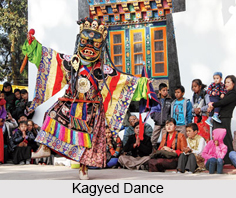 Kagyed Dance is held before Losoong, the New Year and the dance usually symbolizes the destruction of the evil forces before the advent of the New Year. The dance is performed on the 28th and 29th day of the 10th month of the Tibetan Calendar. This day usually falls in the month of December. Kagyed is a Buddhist festival held in parts of north-eastern India, particularly Sikkim. This dance is performed by the monks in the Tsuk-La-Khang Palace Monastery compound two days prior to Losoong, the Sikkimese New Year.
Kagyed Dance is held before Losoong, the New Year and the dance usually symbolizes the destruction of the evil forces before the advent of the New Year. The dance is performed on the 28th and 29th day of the 10th month of the Tibetan Calendar. This day usually falls in the month of December. Kagyed is a Buddhist festival held in parts of north-eastern India, particularly Sikkim. This dance is performed by the monks in the Tsuk-La-Khang Palace Monastery compound two days prior to Losoong, the Sikkimese New Year.
Etymology of Kagyed Dance
Kagyed Chaam is a word of Bhutia origin. "Ka" means "oral transmission", "Gyed" means "eight" and "Chaam" means ritualistic dance. Thus, "Kagyed" actually means the "oral transmission of the 8 Tantric Gods found in Tantric Buddhism".
Rituals for Kagyed Dance
The ritual dance culminates with the burning of effigies made of flour, wood and paper, symbolizing the destruction of the forces of evil. The dance prayers are offered by the monks inside the chapel for peace and prosperity for every Sikkimese home. Thousands of devotees flock to see the dance. Their attendance is confirmed due to their inherent belief that to see the dance is to participate in the exorcizing of evil and ushering in of peace and prosperity for the coming year.
Performance of Kagyed Dance
Kagyed is a form of Cham Masked Dance performed by Buddhist monks and lamas. The masks represent scores of human, deities and animal faces enacting an interesting story from the Buddhist mythology. Although the dance is very serious in nature, jesters are performed in between to provide comic relief. The masked lamas jump and sway to the rhythm of echoing drums and trumpeting horns, gracefully in perfect coordination with their fellow dancers.
Kagyed Dance is held every year at various Sikkimese Monasteries such as Rumtek Monastery, Enchey Monastery, Rabong Monastery and Phodong Monastery.
This article is a stub. You can enrich by adding more information to it. Send your Write Up to content@indianetzone.com.



















